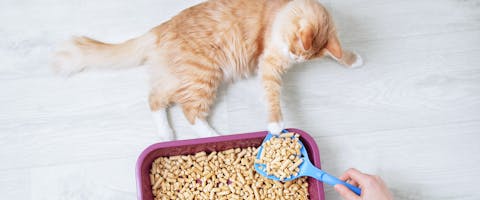Did you know eco-friendly cat litter is a thing? When we say eco-friendly cat litter alternatives we mean what are the best natural cat litter options. This means it’s not synthetic or clay-based litter that is not biodegradable. While these traditional cat litter options are good cat litter options when it comes to odor control, high absorbency, and cost, it doesn’t mean natural cat litter can’t fill that void!
Here are the best natural cat litter alternatives which are an eco-friendly option with sustainable sourcing while also being good cat litter (and safe for cats).
Trending posts
Purr-use some of the top blogs our members have been loving this month- Top male dog names for your new furry friendGot a new furry family member in your pack? Check…

- Top female dog names for your new fluffy palWelcoming a new pooch into your family? Explore…

- 250+ gray cat names your silver feline will loveRecently welcomed a fluffy gray bundle of joy into…

- What are normal pet sitting rates?Discover the average pet sitting rates for animals…

- Unique dog names to stand out from the packDare to be different with our list of the best…

Eco-friendly cat litter alternatives
Wheat
Wheat-based cat litter is perhaps as similar to clay-based litter from our selection of alternative options. It has an almost identical texture to traditional cat litter options, with the same ability to clump well, and easily reuse. Some people even go so far as to grind up their own wheat granules to make homemade kitty litter! Otherwise, many pet stores now stock wheat-based cat litter alternatives these days.
Corn litter or corn-based litter
Ground-up pieces of corn and corn husk are produced as waste products from agricultural manufacturing, so it comes with a big green tick on it! Not only is corn-based litter biodegradable, but it also neutralizes smells, creates easy-to-scoop litter clumps, and can thrown in the compost or food waste trash. Some cornlitter can even be flushed, but be sure to check the packaging first!
Wood shavings & sawdust
There’s something so cleansing and comforting about the smell of wood shavings and sawdust. It’s a natural order loved by many humans and it also makes great eco-friendly cat litter. Sawdust is excellent for litter clumps, and both work against stinky smells, it can all be reused once the soiled bits are removed. It’s so effective, that we humans used to use it inside ye olde pubs and saloons to absorb fallen food and drink.
Grass seed cat litter
For dog parents, grass seeds are a bit of a nemesis. But for cat carers grass cat litter is a super substitute. As well as being lightweight and something you can harvest yourself, it clumps brilliantly and also prevents stinks. The only problem - it gets everywhere, and we mean everywhere!
Pine pellets
Like the wood shavings, pine already comes with a wonderful natural aroma which is great for masking even the pongiest of pongs. Some companies provide ground-up pine bark in pellet form to make biodegradable cat litter. Although it smells great, it’s not the best kitty litter alternative for clumping meaning it needs to be emptied more often.
Soil and earth
If you have an outside cat in your family, this may already be their bathroom of choice. Some kitties prefer to do their business alfresco, so why not bring the outdoors inside? Soil is one of the healthiest cat litter substitutes - it’s sustainably sourced and literally from the earth. Use a combination of dirt from a garden with some potting soil (for comfort, of course) and spread that in your kitty’s litter box. Put a mat underneath the tray to prevent track marks, and throw it out in your garden waste trash.
Sand
Probably the next best thing to soil and dirt, sand is absorbent, and clumpy when wet, and cats absolutely love to dig in it. Of course, to be as eco-friendly as possible, you simply need to head to your nearest beach or desert to collect your own cat litter alternative. However, if you don’t have this as an option, cheap bags of sand can be bought by the sackload at hardware stores.
Concerns about biodegradable cat litter
We all try to be as green as possible, and most of us would prefer to be using biodegradable, eco-friendly cat litter alternatives, it does raise a few question marks - will it be as odorless, absorbent, and efficient as clay-based litters? Well, it’ll depend on the alternative. Some come with natural odor control ingredients (wood-based litters, for example).
For those that may not come with a sweet smell or deodorizing powers, try mixing in some baking powder or bicarbonate of soda. Combine one part baking powder (or bicarbonate of soda) with three parts litter - carbon is a natural neutralizer of stinky smells, as well as eco-friendly.
All of the above can be used when toilet training kittens, but we highly recommend starting them on a kitten traditional cat litter and slowly introducing an eco-friendly alternative. Kittens have a tendency to eat kitty litter when they start litter box training, so using something that is guaranteed to be non-toxic is always best.
It’s also important to talk to your vet before deciding to change their litter just in case they experience any sudden allergic reactions or stress symptoms. If you notice your cat peeing outside their litter box or around the home, make sure you tell your vet immediately.
Do you have any biodegradable cat litter suggestions? Head to our Community Forum and share your knowledge (and love for pets) with other cat carers and feline fanatics. You might even find yourself the paw-fect cat sitter on there! Or, you can simply search for cat sitters near you to find a Trusted pet sitter to care for your cutie-pootie kitty.

